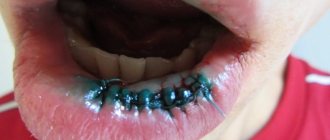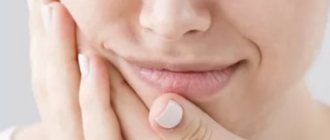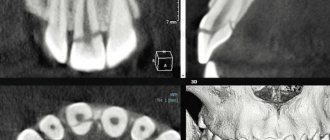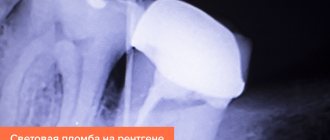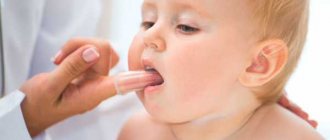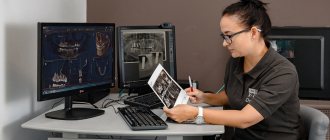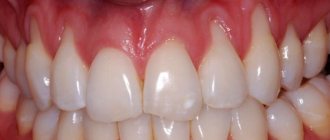A tooth bruise is a common injury that can go virtually unnoticed or lead to serious complications. This is due to the fact that after a blow, the position of the tooth does not change, and the periodontal tissue can suffer greatly. The consequences of a bruise depend on the force of impact. Significant damage can cause tooth loss. Since nerve endings and blood vessels are affected during a bruise, you should contact the dentist immediately, even if there are no external changes or painful sensations.
What it is
One of the most common dental injuries, mostly occurring in childhood, is bruising. Of course, this kind of damage cannot be ruled out in adults, especially those leading an active lifestyle and involved in traumatic sports.
A tooth bruise is a closed injury caused by strong mechanical impact with a hard object. In this case, the integrity of the bone tissue and the anatomical position are not damaged, but the periodontal tissues suffer, sometimes severe rupture occurs, followed by bleeding.
If the blow was so powerful that the neurovascular bundle was damaged, the tooth may become stained or darkened due to hemorrhage into the dentinal tubules and pulp tissue. Occasionally, with a bruise, numbness is one of the accompanying signs, as well as external damage to the facial area in the injured area, as well as the appearance of swelling and bruising. In any case, most often all these damages are reversible and can be treated if you consult a dentist in a timely manner.
Providing first aid for broken, knocked out and dislocated teeth
One of the most common injuries is a fracture. The types of fracture are as follows:
- Chipping of the enamel of a tooth crown.
- Partial tooth destruction without exposing the pulp.
- Chipped crown exposing dental pulp.
- Tooth root injury.
Additionally, the mouth and gums, the jaw itself and the bone nearby can be damaged. If this happens, the first thing you need to do is calm down - the accompanying injuries create additional stress, which significantly interferes with the doctors and the victim himself. In addition, you should try to find broken fragments and leave them in the water until you see a doctor. The situation does not require an urgent visit to the dentist, so you can make an appointment a little later, for example the next day, but try not to involve the damaged tooth until it is restored.
As for diagnosis, everything is simple - the doctor will first conduct an examination. To detect the risk of root injury, the victim is sent for x-rays and electroodontometry. In this way, the condition of the pulp (tooth pulp) is checked. The goal of treatment is to restore the crown of the tooth. If the fracture led to pulpitis, the patient will be treated with subsequent restoration of the pulp. If an x-ray shows that there has been root trauma, complete extraction of the tooth and subsequent placement of a post is often recommended.
The second most common injury is dislocation. This is a partial or complete loss of connection between the tooth and the socket. Dislocation occurs:
- Partial. The tooth moves greatly or slightly, but does not fall out completely.
- Full. The tooth falls out.
- Impacted, in which the dental crown is driven into the gum.
If a temporary tooth has been completely dislocated (falls out of its socket), do not under any circumstances try to return it to its place - you may damage the new permanent one or its rudiment. And in order to look for and insert a molar into place, you will have only 20 minutes. If you manage to do this, the chance of re-engraftment becomes much greater. What is the procedure? As soon as you have discovered the lost tooth, take it with clean hands (it is also advisable to wash it) by the white part, without touching the root, and return it to the hole, orienting parallel to the neighboring teeth. When you return the lost item to its place, bite on a gauze pad or a piece of cloth, such as a scarf.
There are situations when the tooth cannot be inserted back, for example, if the victim is unconscious or the socket is severely damaged. In this case, place the found tooth in milk or saline solution. You cannot put it in water or any other liquid; you can hold it in the victim’s mouth, but there is a risk of swallowing.
Unlike a fracture, in a situation with complete dislocation, it is necessary to urgently visit a specialist for examination and subsequent treatment.
For partial dislocation, the procedure is slightly shorter. It is important to try not to spit (or do it as little as possible) and under no circumstances take out the tooth. If it prevents your mouth from closing, carefully insert it back in with clean hands, focusing on the adjacent teeth. To hold it in place, bite down on gauze or any other piece of tissue.
In the case of an impacted dislocation, first aid is practically useless; the only option is an emergency visit to the dentist.
Panoramic radiography
How are dislocations identified and treated? The doctor first examines and records the complete absence or displacement of a tooth. Next, the victim is sent for an X-ray and radiovisiographic examination, where the location and condition of the alveoli are clarified. In case of incomplete dislocation, the patient is recommended treatment aimed at preserving the tooth and fixing it with the help of special mouthguards and other structures. In addition, medications are recommended to prevent inflammation and infection in the socket, for example antibacterial ones.
If, after complete dislocation, the tooth does not take root, the specialist is forced to resort to prosthetics and implantation. In case of impacted displacement, you can either remove the affected tooth and replace it with an implant, or perform immobilization using local anesthesia.
A knocked out tooth is a dislocated or broken crown due to a mechanical injury. For example, a blow to the jaw caused the victim to completely dislocate or chip the dentin, exposing the pulp. Depending on the injury detected, you can provide first aid as described above. That is, if a tooth falls out, find it, try to put it back in, or place it in saline before visiting a doctor.
Causes
Like any other injury, a tooth bruise can have a wide variety of causes. This could be an accidental hit in the jaw with a ball or other sports equipment, an unfortunate fall, a strong blow in a fight, or the consequence of a road accident or riding a bicycle. All these reasons have one thing in common - a strong blow of a mechanical nature.
Children and athletes are the most vulnerable to such injuries. It is these two categories of patients with a similar diagnosis that are the most frequent visitors to dental clinics. However, household injuries, as a result of which a person accidentally or recklessly hits a tooth, can cause a bruise. In this case, the most unprotected and weakest anterior and lateral incisors on the upper jaw most often suffer due to the anatomical structure and overhang of the upper jaw over the lower jaw.
Prevention of dental injuries
There are typical situations in which children injure their teeth. For example, a quarter of front tooth injuries between the ages of 1 and 3 years occur in the bathtub when a child slips and hits the edge of the bathtub, so try not to leave your baby unattended in the bathtub. Pay attention to protecting your teeth with a mouthguard when your child plays sports, especially hard and contact sports (hockey, various types of wrestling, basketball), rollerblading or skateboarding. Contact your orthodontist in a timely manner, because... a large percentage of injuries to permanent teeth are associated with their incorrect position, i.e. existing bite pathology, which means an additional risk.
At the same time, you should not blame yourself for not looking after your child and causing dental injury. Children are restless, they love to explore the world and take risks, and we cannot always protect them from such accidents.
make an appointment with a pediatric dentist online or by phone: +7(812)3310000
Symptoms
The symptoms accompanying a tooth bruise are easy to recognize. If a person bruises a tooth, it hurts quite noticeably, and over time the pain only intensifies, especially with pressure on the damaged area and chewing food. The following symptoms are also present:
- When the neurovascular connection is ruptured, hemorrhage occurs into the pulp tissue, due to which the enamel quickly turns pink;
- The crown may darken;
- When bruised, the tooth becomes loose, although its mobility is relatively small;
- At the site of impact on the soft tissues of the gums, swelling, hyperemia, deformation of individual areas of the mucous membrane, and the formation of hematomas may occur;
- If there is a very strong impact, ligament rupture, joint damage, or even a fracture of the alveolar process of the jaw may occur where the striking object hits the jaw. In this case, it will be difficult and painful for the patient to open and close the jaw. Such damage can only be diagnosed with an x-ray.
What to do if your teeth are loose and your gums hurt
When gums bleed and become inflamed, teeth can also become loose and even fall out. One of the factors that provokes this condition is acute or chronic gingivitis. The inflammatory process provokes a light plaque on the teeth consisting of microbial pathogens or the formation of tartar on the teeth if you do not take good care of the oral cavity. If gingivitis is not treated, the germs travel deeper into the tissue. Periodontitis develops when pus forms on the gums, the necks of the teeth are exposed, and constant pain appears.
With periodontitis, the inflammatory process occurs in the tissues, from the base of the tooth root. At the same time, gumboil appears and the gums become very swollen and painful. Sometimes, due to chronic infection, cysts form on the gums; they do not appear immediately. In severe cases, a granuloma forms on the gums, in which bacteria attack the gums and roots of the teeth. In this case, the person experiences severe itching and high fever.
Also, gums can hurt after tooth extraction, installation of implants, braces, appliances, or improper dental treatment.
If your teeth are loose in your gums, you should not:
- Press your finger on the gum
- Heat with compresses, sand, warm rinses
- Open an abscess at home
- Taking too many painkillers
First of all, you need to relieve pain with pills or injections. But under no circumstances should you exceed the dosage. Paracetamol, analgin, ketanol and other similar products are suitable. You can also use gels with an analgesic and cooling effect.
You can rinse your mouth with Chlorhexidine and Miramistin. This needs to be done in the morning at lunch and in the evening to get results.
Consequences
Not a single injury for a person passes without a trace. Even if you managed to avoid obvious complications at the time of treatment, there is always a possibility of their occurrence in the future. For a tooth bruise, the consequences are also no exception. One of the most common complications is the gradual death of pulp tissue if the pulp was damaged by an impact, but during treatment, identifying its viability gave positive results. With necrosis, the nerve endings in the tooth cavity are damaged, which inevitably leads to inflammation.
Another most common consequence of a bruise is staining of the enamel. Most often, it occurs in a short time after injury, since fluid from damaged vessels enters the dentinal tubules and stains the walls. In addition, the enamel may simply darken due to a lack of nutrients supplied through damaged fibers and tissues.
More serious complications that arise over time are also possible. This may be the development of a cyst, periodontitis, or a stop in root development in children in both milk and permanent teeth.
Splinting teeth
The method is aimed at strengthening the teeth in the gums and preventing their further loosening. The essence of the manipulation is to combine mobile units into one block with healthy ones using a special fixing structure. Splinting can be temporary ( up to 1-3 months
), long-term (
up to 1 year
), permanent. Tires are divided into:
- removable
– mouthguards, clasp dentures; - non-removable
- tape, fiberglass or aramid thread, crowns, pin inlays (intradental splints), cap splints.
An effective option is fiberglass splinting
, aesthetic nanomaterials or ceramics. A strong, translucent white tape or thread is fixed to the inner surface of the teeth using a light-curing composite. The material is biocompatible with the human body, does not absorb saliva, does not enter into chemical reactions, firmly adheres to the enamel, and reliably holds the units in the desired position.
With temporary splinting, the structure is fixed for several months. This option is used for mild forms of periodontitis, periodontitis, to consolidate the result of orthodontic correction or mobility caused by injury. A permanent splint is installed in the treatment of moderate periodontitis, the presence of voids in the row (removed or fallen units). The fixing structure is replaced with a new one every 4-5 years
, sometimes more often (according to indications).
Splinting clasp prosthesis
Clasp prosthesis
– metal base (arch) with plastic gum and artificial crowns. Since the design has an attachment for each dental unit, the prosthesis can replace several lost teeth while simultaneously splinting loose elements. This method is used in the treatment of pathologies of moderate severity, when in addition to movable units there are healthy ones that serve as support for the prosthesis.
Splinting with crowns
The teeth are depulped, the root canals are filled, ground, and crowns made of durable material (metal-ceramics, ceramics, etc.) “soldered” to each other are fixed on them. This method is characterized by high reliability and long service life. The elements under the crowns are firmly locked together and completely motionless.
Diagnostics
What action should you take if you or your child gets a tooth bruise? First of all, you need to contact a dental clinic as soon as possible. Using an X-ray, as well as after palpation and a thorough visual examination, the doctor will determine the extent of the damage resulting from the bruise, and will also draw up a detailed plan for further treatment.
When a tooth is bruised, diagnosis must certainly include, in addition to identifying obvious symptoms, an x-ray examination to exclude possible internal injuries, such as a fracture of the root or alveolar process. In addition, damage to the periodontal area, if present, will be visible in the image.
Also, over the course of several days, the doctor must monitor the condition of the pulp using electroodontodiagnosis. It helps to identify even the initial stages of necrosis and remove damaged tissues in time before they begin to become inflamed.
Degrees of mobility
- I
– the tooth deviates back and forth from neighboring units
by no more than 1 mm
, there are no symptoms from the periodontium or gums; - II
– amplitude of swing back and forth and sideways
by 1 mm or more
, tartar and plaques are visible on the enamel, redness, swelling, bleeding and soreness of the gums are possible; - III
– the teeth swing strongly in any direction with slight pressure with the tongue or chewing, the amplitude of the displacements
significantly exceeds 1 mm
; - IV
– the tooth shifts in all planes, rotates around its axis, and
barely stays
in the gum tissue.
Pathological mobility of any degree requires complex treatment. If the tooth is located in the gum, the periodontium and socket are intact, the process is reversible. Dental units begin to become very loose when periodontitis or periodontal disease is advanced. With deep periodontal damage, weakening and destruction of the ligamentous apparatus, bone atrophy, tooth extraction may be required, followed by implantation and prosthetics.
Treatment
In some cases, if the impact is not very strong, no treatment other than monitoring the condition of the damaged area is required. It is necessary to provide the affected tooth with long-term rest, apply cold compresses to reduce the bruise and relieve swelling. Solid food is completely excluded from the patient's diet for several days. Among other things, the doctor must observe the injured tooth for two to three months to avoid complications.
In children with baby teeth, it is possible to grind off the enamel on the cutting edge to remove the load from the damaged area; this action is not carried out on permanent teeth.
To eliminate the consequences resulting from a severe bruise, treatment should consist of a number of procedures:
- first of all, the damaged area is numbed with an anesthetic;
- if there is damage to the pulp sac, the doctor performs trephination, depulpation and thorough treatment of the dental cavity with disinfectants, after which the canals are sealed;
- if the neurovascular bundle has been damaged and the enamel has darkened or become stained, it is recommended to bleach permanent teeth using hydroperite, which will return the enamel to a more or less natural color;
- if necessary, the doctor can prescribe, in addition to complete rest, anti-inflammatory drugs and physiotherapy to help quickly eliminate the consequences of the injury.
Even if there is no severe pain after a blow to the jaw, it is recommended to visit a dentist to identify possible hidden injuries. This will help you maintain the health of your teeth for many years to come.
Clinical picture
First of all, the doctor conducts a visual examination of the bruised area to identify hidden injuries that cannot be identified by a person without medical education. For example, symptoms of dislocations or fractures may not appear immediately. Professional consultation allows you to begin timely treatment, if required.
To recognize a jaw bruise, it is important to pay attention to the following symptoms:
- severe pain in the place where the blow fell, intensifying when pressed;
- visual signs (eg, swelling, redness, abrasions, bruises);
- limitation of jaw mobility when yawning, talking, chewing;
- inflammation of the lymph nodes;
- general weakness.
Jaw bruises are less dangerous than more severe injuries, so recovery is usually quick.
The doctor may order an x-ray or computed tomography to establish an accurate diagnosis. These studies will assess the condition of the internal tissues of the affected area.
The likelihood of tooth loss after injury: what doctors say
Can a tooth fall out after a blow? This situation is rare, but it cannot be excluded if the supporting ligaments and periodontal tissues are severely damaged, and the person does not seek dental care for a long time.
More often, after a blow, the tooth hurts and only wobbles a little, and the gums around it are red and swollen. But even in this case, you cannot relax. According to doctors, against this background traumatic gingivitis and periodontitis can develop. These diseases, with inadequate treatment and careless attitude to oral hygiene, progress and become generalized (spread to the entire range). Advanced periodontitis is also fraught with loosening and loss of moving elements.
Complications after injury
Usually bruises do not affect the health of the teeth in any way, but sometimes they lead to complications. Among the most common are a strong change in the color of the enamel against the background of hemorrhage that appears in the pulp chamber. Over time, a damaged tooth may become gray or brown, this is due to a slowdown in metabolic processes occurring in the tissues.
If the pulp dies, a disease such as pulpitis may develop. If you ignore the first symptoms, the risk of developing periodontitis becomes very high. As a result, a post-traumatic odontogenic cyst may appear, which is localized on the upper part of the tooth root.
If a child whose molars have already emerged is injured, the development of the roots of permanent units may be disrupted. If the injury is in a very young patient, it can cause a disruption in the formation of the rudiments of future permanent teeth. In the absence of timely intervention, they may die.

